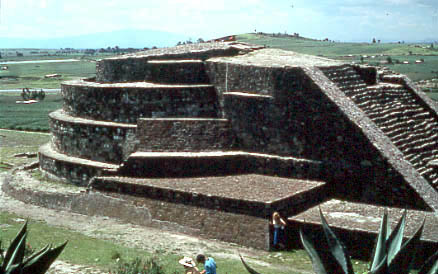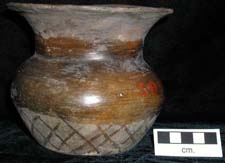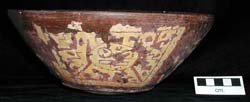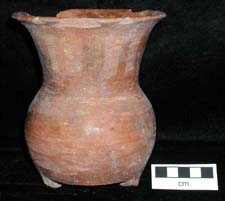Classic-Period Ceramics from
Calixtlahuaca
by Dr. Michael E. Smith
Professor of Anthropology, Arizona State University

View the Vessels
The
ceramic vessels posted on these pages were excavated in the 1930s by
Mexican
archaeologist José García Payón at the site of
Calixtlahuaca, just north of
Toluca in the State of Mexico. As described in other places (Smith, et al. 2003),
(Smith 2003),
these excavations remain poorly documented (see also
my discussion of the so-called Roman figurine from the site).
García Payón
published very little during his lifetime (García
Payón 1936, 1941a, b).
Two books of a planned three-book series were
published posthumously (García Payón
1979, 1981),
but the third manuscript was lost.
The
important conclusion from the poor level of documentation is that the
proveniences of the surviving artifacts are not known. As I describe
elsewhere,
it is very likely—but not certain—that all of the Classic period
vessels posted
here were indeed from Calixtlahuaca. I post these vessels to aid
scholars in
documenting the nature of Teotihuacan contacts and exchanges within the
central
Mexican highlands. I am not an expert in Classic period ceramics, and I
welcome
comments from colleagues on the dating and possible significance of
this
collection. The stone architecture at Calixtlahuaca, excavated by
García Payón,
all appears to date to the Postclassic period.
The
photographs of vessels were taken with a digital camera in 2002 during
research on
the
Postclassic ceramic vessels of Calixtlahuaca. The research team
consisted of
myself, Jennifer Whatron, and Melissa McCarron; our preliminary results
have
been published (Smith, et al. 2003).
Our research was funded by the Foundation for the
Advancement of Mesoamerican Studies, Inc. Our research was aided
greatly by the
Directors and staffs of the Instituto Mexiquense de Cultura (Gobierno
del
Estado de México) and the Centro INAH Estado de México,
both in Toluca.
Permission to post these images has been granted by the Instituto
Mexiquense de
Cultura and by the Instituto Nacional de Anthropología e
Historia.
Other
sources on the Classic period in the Toluca valley include the
following: (Díaz Oyarzábal 1998;
González de la Vara
1999; Nieto Hernández 1998; Piña Chán 1987;
Sugiura Yamamoto 1981, 1998, 2002).
View
the Vessels



REFERENCES:
Díaz
Oyarzábal, Clara Luz
1998
Ocoyoacac:
un sitio con influencia teotihuacana en el valle de Toluca.
In Los ritmos de cambio en
Teotihuacán: reflexiones y discusiones de su cronología,
edited by Rosa
Brambila, and Rubén Cabrera, pp. 353-375. Colección
Científica, vol. 366.
Instituto Nacional de Antropología e Historia, Mexico City.
García
Payón, José
1936
La zona arqueológica de
Tecaxic-Calixtlahuaca y los matlatzincas: etnología y
arqueología (primera
parte). Talleres Gráficas de la Nación, Mexico City.
1941a
La cerámica del Valle de Toluca. Revista
Mexicana de Estudios Antropológicos 5:209-238.
1941b
Manera de disponer de los muertos entre los matlatzincas
del Valle de Toluca. Revista Mexicana de
Estudios Antropológicos 5:64-78.
1979
La zona arqueológica de
Tecaxic-Calixtlahuaca y los matlatzincas: etnología y
arqueología (textos de la
segunda parte), edited by Wanda Tommasi de Magrelli and Leonardo
Manrique
Castañeda. Biblioteca Enciclopédica del Estado de
México, vol. 30. Estado
de México, Toluca.
1981
La zona arqueológica de
Tecaxic-Calixtlahuaca y los matlatzincas: etnología y
arqueología (tablas,
planos e ilustraciones de la segunda parte), edited by Leonardo
Manrique
Castañeda. Biblioteca Enciclopédica del Estado de
México, vol. 31. Estado
de México, Toluca.
González
de la Vara, Fernán
1999
El Valle de Toluca hasta la caída de
Teotihuacan. Colección Científica, vol. 389.
Instituto Nacional de
Antropología e Historia, Mexico City.
Nieto
Hernández, Rubén
1998
Excavaciones en el valle de Toluca:
propuesta sobre un secuencia cultural. Tesis de Licenciatura,
Department of
Arqueología, Escuela Nacional de Antropología
e Historia.
Piña
Chán, Román
1987
El Estado de México antes de la Conquista.
Universidad Autónoma del Estado de México, Toluca.
Smith,
Michael E.
2003
Postclassic Urbanism at Calixtlahuaca:
Reconstructing the Unpublished Excavations of José García
Payón. Report to
the Foundation for the Advancement of Mesoamerican Studies, Inc. Posted
on the
internet at: http://www.famsi.org/reports/01024/.
Smith,
Michael E., Jennifer Wharton, and
Melissa McCarron
2003
Las
ofrendas de Calixtlahuaca. Expresión
Antropológica 18: (in press).
Sugiura
Yamamoto, Yoko
1981
Cerámica
de Ojo de Agua, Estado de México, y sus posibles relaciones con
Teotihuacan. In Interacción
cultural en México central, edited by Evelyn C. Rattray,
Jaime Litvak King,
and Clara Díaz Oyarzábal, pp. 55-80. Instituto de
Investigaciones
Antropológicas, Universidad Nacional Autónoma de
México, Mexico City.
1998
El
Valle de Toluca después del ocaso del estado Teotihuacano: el
Epiclásico y el
Posclásico. In Historia general del
Estado de México, vol. 1: geografía y arqueología,
edited by Yoko Sugiura Yamamoto, pp. 199-259. Gobierno del Estado de
México and
El Colegio Mexiquense, Toluca.
2002
Después
de Teotihuacán: Epiclásico del Valle de Toluca: caos y
orde, dos caras de una
moneda. In Arqueología Mexicana,
historia y esencia, siglo XX, edited by Jesús
Nava, pp. 209-22. Colección Científica, vol. 436.
Instituto Nacional de
Antropología e Historia, Mexico City.
Back to the Calixtlahuaca Project Data Page
Back to the Matlatzinco Home Page
Related Links:
(1) The Bauer
Collection at the American
Museum of Natural History (Postclassic ceramic vessels from the Toluca
Valley)
(2) Techialoyan
style polychrome pitchers. I have posted some images of
a
very unusual style of ceramic vessel to solicit feedback. Do these look
Pre-Spanish
(Postclassic) or could they date to the Colonial period?
(3) Also, for the diffusionists and
anti-diffusionists
out there:
Click Here for
information
on the “Roman” figurine supposedly excavated at Calixtlahuaca.
- Michael
E. Smith's Home Page
- Information about research and publications.

© 2006, Michael E. Smith (updated
10/24/06)




